Garnishes have come and gone throughout the history of cocktails, but the simple garnish has recently received a makeover, and a renaissance is in full swing. Cocktails, mixed drinks, shakes, and even coffees can be elevated with a simple and not-so-simple garnish to stand out from the crowd and wow your guests.
There are no hard and fast rules, and it’s important to remember that what’s simple and elegant in one place may be dull and boring in another. Similarly, something bright and vibrant will be perceived as excessive in some areas. You know your market and what your customers like, so don’t be afraid to try new things within the constraints of cultural expectations and norms.
An eye-catching or signature garnish can serve as a visual representation of your bar’s identity, style, and ethos. Some bars go for simple garnishes and drinks, while others go for Instagram-worthy garnishes and fantastic creations. Determine where your bar, café, or restaurant falls on this spectrum of garnish creativity and begin brainstorming ideas.
List of Some of the Best Cocktail Garnishes
The presentation of a cocktail may not appear to be necessary at first glance, but it is an essential part of the drinking experience. Garnishes can improve the visual appeal, aromas, and subtle flavours of cocktails, which can affect the final product. These minor details can have a significant impact.
As you might expect, there are numerous fancy garnishes to choose from, and arranging them on your cocktail can be a lot of fun. We hope this article on the eight best cocktail garnishes inspires you to up your cocktail game.
Dehydrated fruit Garnish
Dehydrated fruits can help you save both time and money. Unlike fresh ingredients, dehydrated fruits are already sliced and ready for garnishing. When using readily available dehydrated fruits to garnish your cocktails, the preparation time can be significantly reduced, especially when making multiple servings.
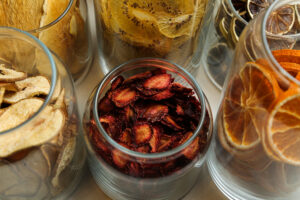
Also, dehydrated fruits have a much longer shelf life than fresh fruits when stored properly. Furthermore, fresh garnishes such as citrous wheels spoil quickly. Wasteful ingredients can thus be avoided. Cocktails with sparkling gin and raspberry-flavoured syrup benefit from the addition of dehydrated raspberries. This fruit is completely dehydrated rather than chopped into slices for garnishing.
Although almost any fruit can be dehydrated, the most common fruits dried for garnishes are lemons, oranges slices, pineapples, limes, mangoes, and berries. Dehydrated fruits add a sophisticated touch to any cocktail.
Fruit can be dehydrated using only an oven, microwave, or food dehydrator. Traditional cocktail fruit garnishes include dried passion fruit, lemon wedges, dried lime wedges, and berries, but you can get creative with other options.
Edible Flowers
Flowers are not only beautiful but also delight our senses in a variety of ways. Cocktail garnishes made from edible flowers add a lovely splash of colour to cocktails. Adding flowers to the cocktail will enhance the experience.
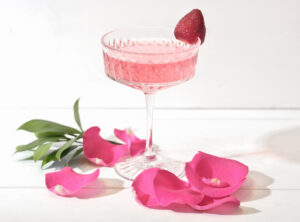
Lavender, violas, roses, nasturtiums, and orchids are some edible flower options. However, keep in mind that not all flowers are appropriate for a garnish. Some flowers, for example, are poisonous. Please be cautious. Before eating certain flowers, do your homework.
Pretty edible flowers elevate an ordinary cocktail to a blooming good cocktail. They add floral aromas and texture whether used fresh, dried, or candied. The flower you choose is really determined by the size of your glass and the type of drink you want to adorn.
Dried flowers such as lavender, rose, and camomile is simple and often found in the baking aisle of the store. For the less obvious, try elderflower or honeysuckle clusters for a show-stopping cocktail flower garnish. They’re as fragrant and beautiful as cherry blossoms. Violets (and violas) and pansies are perennial favourites. Choose a large hibiscus or peony, or simply pick off a few petals and place them on your glass with a mini clothespin.
Cocktail onions
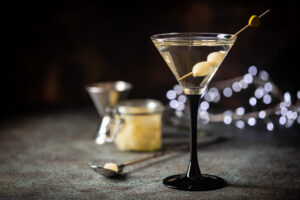
A perfect cocktail onion should be crisp and have a hint of flavour other than piquant onion. Cocktail onions are typically sweeter due to their small size; small pearl onions are ideal. Pearl onions go well with a variety of drinks due to their inherent sweetness. Fresh pearl onions are just as good in cocktails as frozen ones, but if you can find them, use fresh ones because their flavour is fresher and crunchier. Cocktails can be topped with brined onions. Because brined onions retain a slightly crisp texture, they add a distinct flavour to cocktails.
The Gibson cocktail, a Martini with a cocktail onion instead of the traditional olive garnish, uses cocktail onions.
Citrus twist
>Citrus twists are simple garnishes made by twisting a thin strip of citrus peel. Traditionally, an orange or lemon twist is used to finish the cocktail, but a lime twist is also delicious. With the exception of the peel, the fruit is whole and can be juiced without losing nutrients.
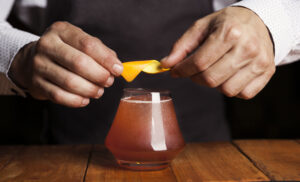
There is no doubt that the citrous twist garnish is one of the most difficult to make, and the best advice is to practise until you have mastered the technique. The step-by-step instructions below will show you how to make a perfect citrus twist.
Place a citrus fruit in your palm and grip it tightly. With a canelle knife, cut the citrous peel, digging deep enough to get a bit of the white pith. Roll the fruit in your hand in a smooth, consistent motion, cutting a strip of peel from the fruit as you roll it. Stop or wait until the peel naturally falls off once you’ve reached the desired length. Spiralise the peel as tightly as possible without breaking it, then gently squeeze it. To keep your twists tighter and more pliable, immediately immerse them in ice water after creating the spiral. Roll it into a tight spiral again just before garnishing the drink.
Carved citrus peel
Carve patterns into your citrus peel and have fun with it. Carving citrous peels is probably the most inventive task we’ll assign you. When you do a deep dive into creative garnishes on social media, let your imagination run wild. The majority of the clever creations are actually quite simple to execute. You might only need a couple of practice runs to get it right. Simple victories include rolling a strip of peel into a rosette. For a more nuanced effect, carve a leaf shape and remove a few small nodes.
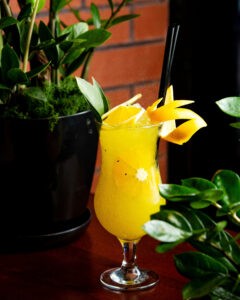
Trim a 3-inch long piece of peel about 1 inch wide for a citrous carved fan (like you would a twist above). Cut an angle at the top and a straight line across the bottom. Make five thin cuts into the angled end and one-third into the strip. Make a cut in the centre, like the twist above, if you want it to anchor on the glass, or sit it in the base of your glass to burst out of the cocktail.
Cocktail cherries
Cocktail cherries vary depending on their type, preservation method, and whether or not they are spiked with a liquor-like brandy. Maraschino cherries were originally fresh cherries marinated in maraschino liqueur, and such cherries are still produced and sold by companies like Luxardo.
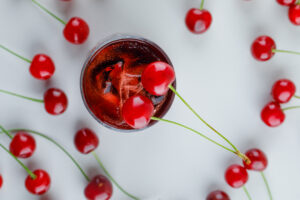
In 1905, Luxardo cherries were the first cocktail cherries invented. These cherries are small, dark red, and preserved in cherry syrup. They almost appear black. Their flavour is intense and complex; it’s rich, sweet-tart, and fruity, with a nutty amaretto finish. The bright red commercial maraschino cherries found in Shirley Temples are an imitation of the original Luxardo cherries.
Cocktails like the Old Fashioned or the classic Manhattan are ideal for garnishing with Luxardo cherries. Luxardo and maraschino cherries should be stored in syrup/liqueur and refrigerated.
Olives
Many different cocktail recipes call for an olive garnish. The most popular cocktails to serve with an olive are the dirty martini and the Manhattan. Instead of the dryness of a dirty martini, olives will add a slight tang. If you prefer whisky to lighter spirits, the Manhattan is the cocktail for you.
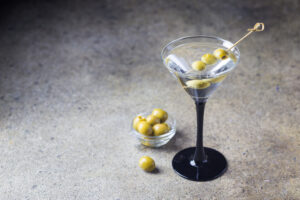
We’ll just talk about olives in dirty martinis for the sake of simplicity and because it’s the most common place for an olive in a cocktail.
There are various degrees of ‘dirtiness’ in your martini; a dirty martini can range from slightly dirty to filthy. A ‘little bit dirty’ means adding an olive straight from the jar to a martini without rinsing off the brine. Filthy, on the other hand, is anything that contains more than four teaspoons of brine.
The rules for using olives as a garnish are straightforward: Because of the large hole in the middle, pitted olives will infuse directly into the drink. Don’t use a cocktail stick to impale olives. Refrigerated olives should be stored in the jar in which they were packaged.
Fresh herbs
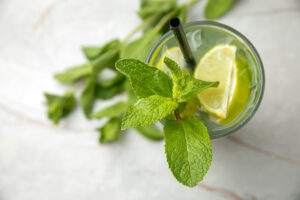
Fresh herbs, such as mint, rosemary, thyme, or lavender, add flavour and aroma to mixed drinks. Herb leaves add visual interest to a cocktail as well. In other cases, the herbs and leaves are purely ornamental and serve only to alert the drinker to a distinct flavour. Mint is one of the most commonly used garnishing herbs. Mint as a garnish improves the flavour of drinks by adding a crisp freshness.
Before adding the fresh herb garnish to the cocktail, slap it against your hand to release essential oils and enhance the flavour.
Awesome Reasons to use Dried Cocktails Garnishes
Dehydrated garnishes are one of those small changes that can have a big impact over time. Every small step we can take to make things simpler, more efficient, more beautiful, and so on has a compound effect on our profitability and joy.
Dry fruits such as apples, lemons, oranges, limes, dried apricots, dried pineapple, and more are among the dehydrated garnishes. However, it can also include unexpected items.
Dried Cocktail Garnishes Last A Very Long Time
Preparing garnishes ahead of time is a no-brainer for saving time, but can you nail down the exact amount you’ll use every time? If that’s the case, you’re basically Nostradamus.
When you pre-prep your garnishes, one of two things happens: you underestimate and are caught short-handed – usually in the middle of the unexpected rush that caused you to underestimate in the first place.
Or you overestimate, resulting in soggy (or dried out) citrous in your customer’s glass and/or a compost full of expensive fruit. It’s not just the fruit itself; it’s also the time spent cutting, storing, and discarding it.
When you dehydrate your garnishes, they become much more shelf-stable. They won’t last forever, but they will give you a much larger margin for error when forecasting your sales and preparing accordingly.
Dehydrated cocktail garnishes allow you to control the cost-per-garnish
Good bartenders are almost perfect humans – but we’re not machines. One person’s cuts will always be thicker or thinner than the next. As a result, accurately assigning a cost-per-garnish amount to your finished drinks is nearly impossible.
If you buy dehydrated garnishes by the piece, the containers usually come with an ‘average contents’ statement – both will allow you to nail down your per-unit costing and manage your inventory with ease.
Dehydrated Citrus Holds Aromatics More Effectively
When you remove the water from something, the remaining ingredients usually become more concentrated. Garnishes are no exception.
We’re mostly talking about aromas here; we’ve discovered that they don’t add much to the flavour. However, the enhanced aromas they impart can be used to a bartender’s advantage. (And they’re still completely edible in case an overzealous customer decides to eat one.)
For true professionals, you can also be confident that a customer will not squeeze a wheel or wedge of lemon or lime into their cocktail, destroying the balance you’ve worked so hard to achieve.
Dehydrated garnishes have numerous advantages and can be used in a variety of ways. There’s a lot to learn about which fruits and vegetables can be dehydrated and how to use them.
Reduces waste by utilising every part of the fruit (Particularly in The Case of Citrus)
Let’s say you have lime and lemon wheels…
Many bartenders I’ve seen waste a significant portion of the fruit on either side of their citrous wheels. While fruit waste accumulates over a shift, each individual piece isn’t large enough to juice or turn into another garnish.
Even if they intend to juice it later, it usually ends up in the compost.
It’s not laziness; it’s simply taking the path of least resistance. It’s in our nature to accept it.
Dehydrated garnishes provide a positive path of least resistance while also reducing waste.
I’ve never seen anyone completely eliminate waste from their bar, but having garnishes that you can prep ahead of time and not have to throw away at the end of a shift goes a long way.
They Look Beautiful
Have you ever heard the phrase “people drink with their eyes”? It’s true: the more appealing your drinks appear, the more likely your customers will enjoy them.
gain, using citrous as an example, the dehydration process significantly darkens the fruit itself. This can provide a dramatic and intriguing contrast to your drinks, allowing you to experiment with really interesting colour combinations – think foams or darkly coloured liquid combinations.
As a Cocktail Garnish, You Can Dehydrate Anything
It’s a great way to energise yourself or your teammates, especially if you’ve been serving the same drinks for a while. Taking a bunch of dehydrated garnishes and throwing some ideas around the bar can really energise and bring a team together.
After all, variety is the spice of life, so add some! (Did someone say “dehydrated chillis?”
